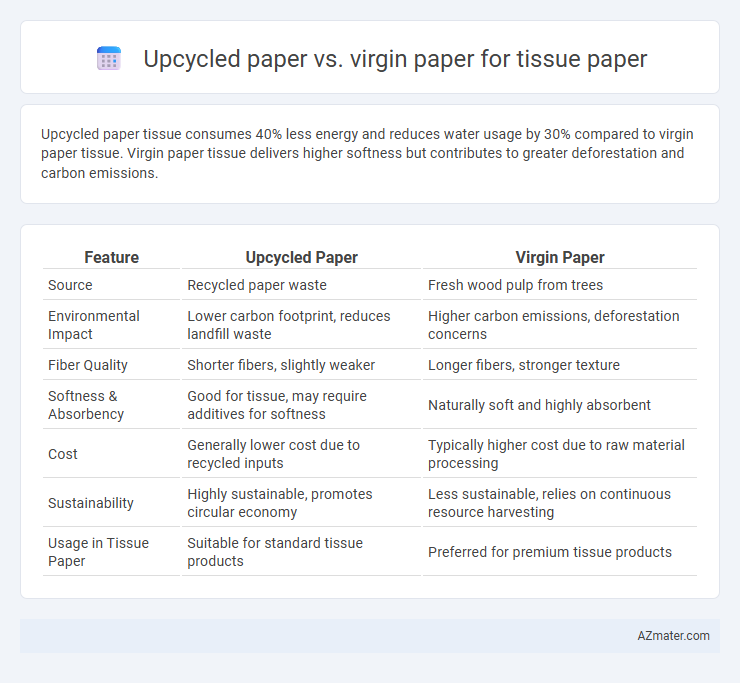Upcycled paper tissue consumes 40% less energy and reduces water usage by 30% compared to virgin paper tissue. Virgin paper tissue delivers higher softness but contributes to greater deforestation and carbon emissions.
Table of Comparison
| Feature | Upcycled Paper | Virgin Paper |
|---|---|---|
| Source | Recycled paper waste | Fresh wood pulp from trees |
| Environmental Impact | Lower carbon footprint, reduces landfill waste | Higher carbon emissions, deforestation concerns |
| Fiber Quality | Shorter fibers, slightly weaker | Longer fibers, stronger texture |
| Softness & Absorbency | Good for tissue, may require additives for softness | Naturally soft and highly absorbent |
| Cost | Generally lower cost due to recycled inputs | Typically higher cost due to raw material processing |
| Sustainability | Highly sustainable, promotes circular economy | Less sustainable, relies on continuous resource harvesting |
| Usage in Tissue Paper | Suitable for standard tissue products | Preferred for premium tissue products |
Introduction to Tissue Paper Production
Tissue paper production relies on high-quality fibers to ensure softness and strength, with virgin paper fibers sourced directly from wood pulp offering superior fiber length and durability. Upcycled paper fibers, derived from recycled paper products, contribute to sustainability by reducing waste and conserving natural resources, though they may result in slightly weaker fiber bonds. Balancing virgin and upcycled fibers is crucial for optimizing tissue paper performance while minimizing environmental impact.
What is Virgin Paper?
Virgin paper for tissue production is made from freshly harvested wood fibers that have not been previously used or recycled, ensuring a high level of purity and strength. It typically offers superior softness, durability, and absorbency compared to recycled alternatives, making it ideal for premium tissue products. The manufacturing process involves mechanical and chemical treatments to extract clean fibers, resulting in consistent quality and performance.
Understanding Upcycled Paper
Upcycled paper for tissue paper is produced by repurposing post-consumer waste, reducing the need for fresh wood fibers and lowering environmental impact compared to virgin paper. This process conserves natural resources, minimizes landfill waste, and decreases energy consumption during manufacturing. Upcycled tissue paper offers sustainable qualities without compromising softness, strength, or absorbency, making it an eco-friendly alternative to virgin fiber products.
Environmental Impact: Virgin vs Upcycled Paper
Upcycled paper for tissue products significantly reduces environmental impact by lowering deforestation rates and decreasing energy consumption compared to virgin paper, which relies heavily on fresh wood pulp. The production of virgin paper generates higher greenhouse gas emissions and consumes more water, contributing to resource depletion and pollution. Utilizing upcycled paper promotes a circular economy by diverting waste from landfills, conserving natural resources, and minimizing the carbon footprint of tissue products.
Resource Consumption Comparison
Upcycled paper tissue production significantly reduces resource consumption compared to virgin paper by utilizing recycled fibers, which lowers the demand for fresh wood pulp and decreases water and energy usage by up to 50%. Virgin paper production requires extensive harvesting of trees, which contributes to deforestation and higher carbon emissions, while upcycled paper mitigates environmental impact through circular resource use. Water consumption for virgin tissue can reach 250 liters per kilogram, whereas upcycled tissue paper uses substantially less due to reduced processing needs.
Energy Use in Manufacturing Processes
Upcycled paper for tissue production significantly reduces energy consumption compared to virgin paper, as it bypasses the energy-intensive pulping of raw wood. Manufacturing virgin paper requires substantial energy to break down lignin and process fresh fibers, resulting in higher greenhouse gas emissions. Using recycled fibers lowers the carbon footprint and supports more sustainable tissue paper production by minimizing energy use.
Quality and Performance Differences
Upcycled paper for tissue products often contains more impurities and shorter fibers, resulting in lower softness and reduced strength compared to virgin paper made from fresh wood pulp. Virgin paper tissues provide superior absorbency, durability, and a smoother texture, enhancing overall user comfort and performance. Although upcycled paper is eco-friendly, virgin paper remains the preferred choice for premium tissue quality and optimal functionality.
Cost Analysis: Upcycled Versus Virgin Paper
Upcycled paper for tissue production generally offers a lower cost compared to virgin paper due to reduced raw material expenses and energy consumption in processing recycled fibers. Virgin paper incurs higher costs from sourcing new wood pulp and intensive manufacturing processes, impacting the overall price of tissue products. Evaluating lifecycle costs, upcycled tissue paper provides a more economical option while supporting sustainable practices.
Consumer Trends and Market Demand
Upcycled paper tissue products are gaining significant traction as eco-conscious consumers prioritize sustainability and reduced environmental impact, driving market demand higher. Virgin paper tissue remains preferred for premium quality and softness, sustaining steady demand in luxury and hygiene-sensitive sectors. The market increasingly favors upcycled options due to rising awareness of deforestation issues and a growing trend toward circular economy practices in consumer goods.
Sustainability in Tissue Paper Choices
Upcycled paper significantly reduces environmental impact by utilizing recycled fibers, lowering deforestation rates, and decreasing energy consumption compared to virgin paper in tissue production. Virgin paper, derived from fresh wood pulp, contributes to higher carbon emissions and greater resource depletion. Choosing upcycled tissue paper supports circular economy principles, promoting sustainable forestry and reducing landfill waste.

Infographic: Upcycled paper vs Virgin paper for Tissue paper
 azmater.com
azmater.com